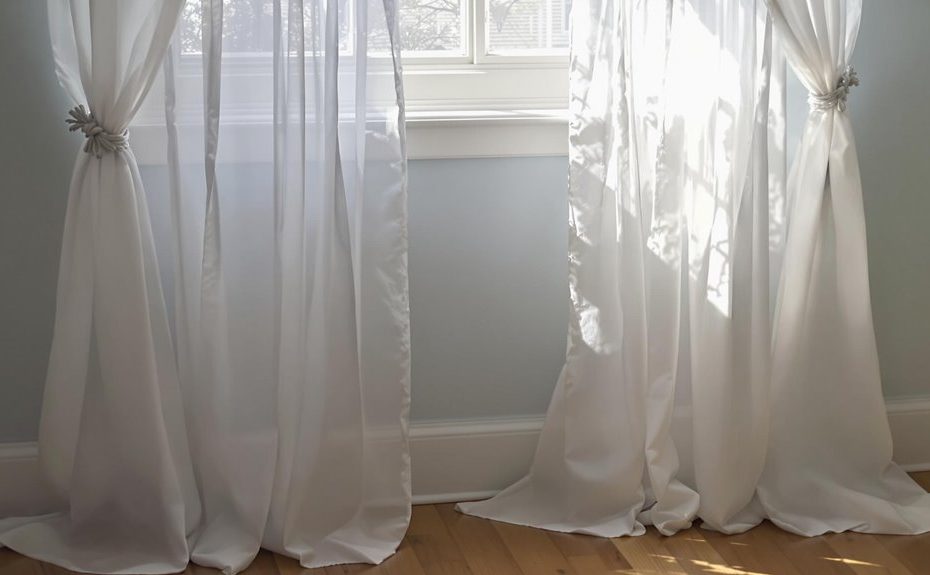Don’t throw away those old bed sheets – they’re a goldmine for eco-friendly DIY projects! You can transform them into reusable produce bags for grocery shopping, protective covers for your garden plants, or drop cloths for painting projects. Get creative by making cozy pet beds, Halloween ghost decorations, or backing material for quilts. Old sheets work great as compost bin liners, picnic blankets, and even fort-building material for kids. These sustainable alternatives save money while reducing waste, and the possibilities don’t stop there – your imagination is the only limit to what you can create.
Reusable Produce Bags
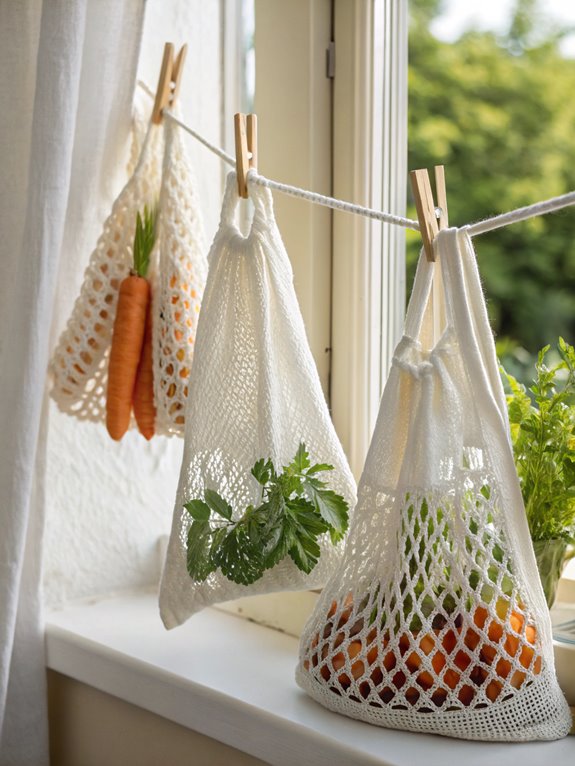
Many environmentally conscious shoppers are turning to reusable produce bags made from old bed sheets as a sustainable alternative to disposable plastic bags at grocery stores. If you’ve got some old sheets lying around, you can easily transform them into durable, washable bags that’ll serve you for years to come.
To create your own produce bags, simply cut your old sheets into rectangles of your desired size, fold them in half, and sew up the sides. You can add a drawstring at the top using cord or ribbon threaded through a folded hem. These bags are perfect for carrying fruits, vegetables, and bulk items like nuts or grains.
Your homemade produce bags will be lightweight, breathable, and see-through enough for cashiers to identify your items easily. Plus, you’ll feel great knowing you’re keeping both sheets and plastic bags out of landfills. You can make them in different sizes – smaller ones for berries and larger ones for leafy greens. When they get dirty, just toss them in the washing machine with your regular laundry, and they’ll be fresh and ready for your next shopping trip.
Plant Protection Covers
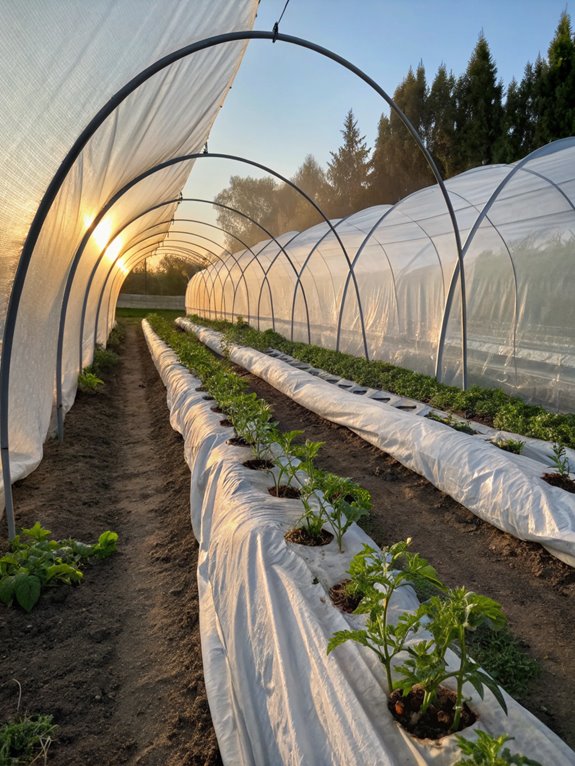
During the challenging growing seasons, old bed sheets can serve as excellent protective covers for your garden plants. Whether you’re facing unexpected frost, harsh sun, or pesky insects, those worn-out sheets can become valuable tools in your gardening arsenal. Simply drape them over your vulnerable plants when frost threatens, or create a light canopy to shield delicate seedlings from intense afternoon sun.
You’ll find that sheets work particularly well for protecting rows of vegetables or clusters of flowers. To use them effectively, prop the sheets up with stakes or hoops to prevent them from crushing your plants. For frost protection, lay them directly over your garden in the evening and remove them in the morning once temperatures rise. You can even cut your old sheets into smaller pieces to wrap individual plants or create custom-sized covers for raised beds.
Remember to secure the edges with rocks, bricks, or garden pins to prevent them from blowing away. Your old cotton sheets are perfect for this purpose since they’re lightweight, breathable, and allow both air and moisture to reach your plants while providing the protection they need.
Drop Cloths for Painting
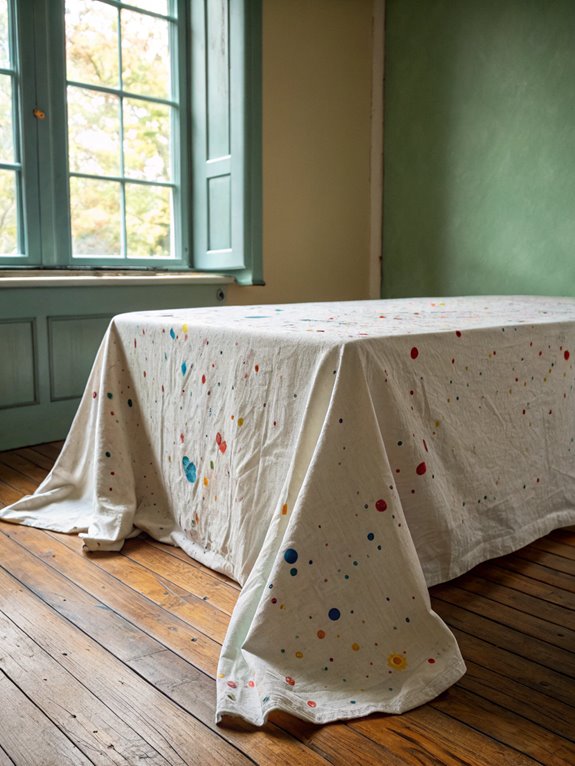
Old bed sheets can find new life beyond the garden as effective drop cloths for painting projects. When you’re getting ready to paint a room or tackle a DIY furniture makeover, protecting your floors and furnishings is essential. Your old sheets can save you money while keeping paint splatters at bay.
Before you toss those worn-out sheets in the trash, consider how perfect they are for painting projects. Cotton sheets are especially useful because they’re absorbent and can catch paint drips before they reach your floor. Simply spread the sheet out, making sure to cover all areas where paint might fall. You can even use multiple sheets for larger projects or to create overlapping layers of protection.
Unlike plastic drop cloths that can be slippery and noisy, fabric sheets stay put and are quieter to work with. They’re also easy to wash and reuse for future projects. When you’re done painting, just shake the sheet outside, wash it, and store it with your painting supplies. If paint does dry on the sheet, don’t worry – it’s already destined for utility use rather than your bed!
Pet Bed Cushions
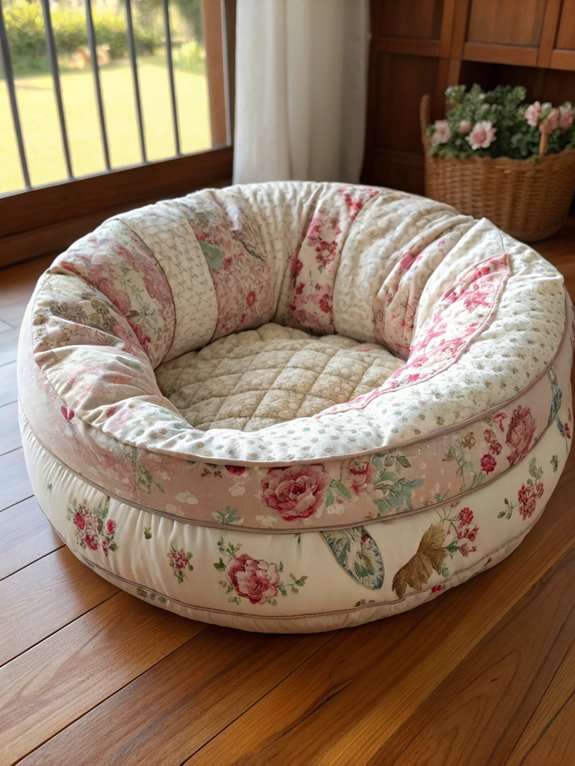
Pet-loving households can transform their retired bed sheets into cozy cushions for their four-legged companions. If you have old sheets taking up space in your linen closet, you can easily turn them into comfortable beds that your pets will love. Simply fold the sheets into multiple layers, or use them as covers for stuffing material like foam, cotton batting, or even recycled clothing.
To create a basic pet cushion, start by measuring your pet’s favorite sleeping spot. Cut your sheet material about two inches larger on all sides to allow for seams. You can double up the fabric for extra durability or use a single layer if you’re adding stuffing. Sew three sides together, turn the fabric right-side-out, fill with your chosen stuffing material, and close the final edge.
For added comfort and style, consider adding a removable pillowcase-style cover that you can easily wash. Your pets won’t care if the patterns match or if the sheets are a bit faded – they’ll just appreciate having their own special spot to rest. Plus, you’ll feel good knowing you’ve given your old sheets a second life.
Garden Weed Barriers
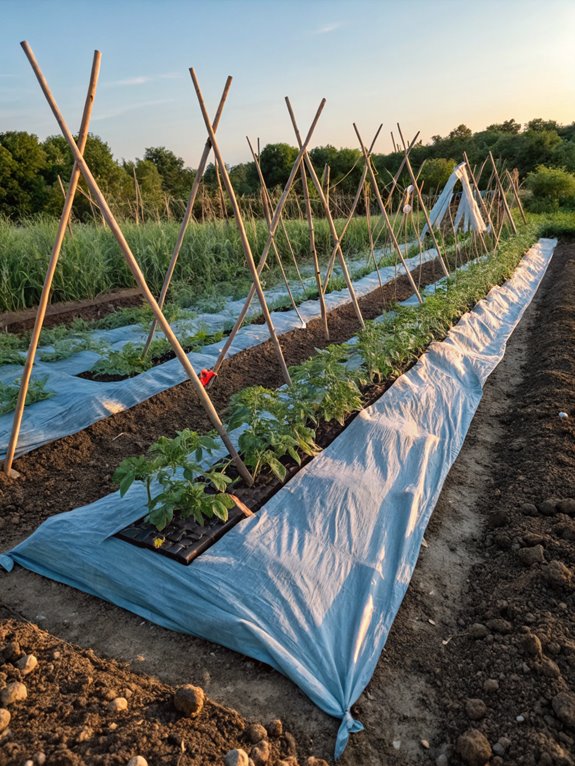
Gardeners seeking eco-friendly solutions can utilize old bed sheets as effective weed barriers in their garden beds. Instead of buying expensive landscape fabric, you can lay down your old cotton sheets to suppress unwanted plant growth while allowing water and nutrients to reach the soil beneath.
To use sheets as weed barriers, simply clear your garden bed of existing weeds and spread the sheet over the area, cutting holes where you want to plant your vegetables or flowers. Secure the edges with landscape pins or heavy rocks to prevent the fabric from blowing away. You’ll want to use light-colored sheets, as dark ones can heat up too much in the sun.
The best part is that cotton sheets will naturally decompose over time, adding organic matter to your soil. While they may not last as long as commercial weed barriers, they’re a perfect temporary solution that keeps textiles out of landfills. Just remember to replace them when they start breaking down – which usually happens after one or two growing seasons, depending on your climate and soil conditions.
Eco-Friendly Gift Wrap
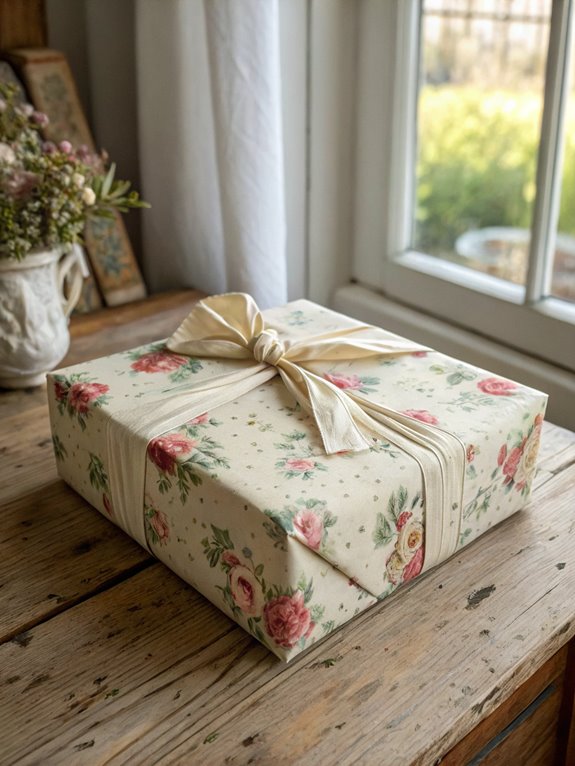
While bed sheets can enhance your garden, they also offer creative solutions for sustainable gift-giving. Instead of buying expensive wrapping paper that ends up in the trash, you can transform your old sheets into beautiful, eco-friendly gift wrap that adds a personal touch to any present.
To get started, cut your clean sheets into various sizes, depending on your gifting needs. You’ll be amazed at how versatile sheet fabric can be – it’s perfect for wrapping oddly shaped items that traditional paper can’t handle. The fabric’s natural drape creates elegant folds and pleats that make your gifts look extra special.
You can jazz up your sheet gift wrap with natural elements like twine, dried flowers, or fabric ribbons cut from the sheet’s edges. If you’re feeling crafty, try using fabric paint to add patterns or personalized messages. The best part? Your recipients can either reuse the fabric for their own gift-wrapping or repurpose it for other projects. By using old bed sheets as gift wrap, you’re not just saving money – you’re also helping reduce waste and showing that you care about the environment.
Dust Covers for Storage
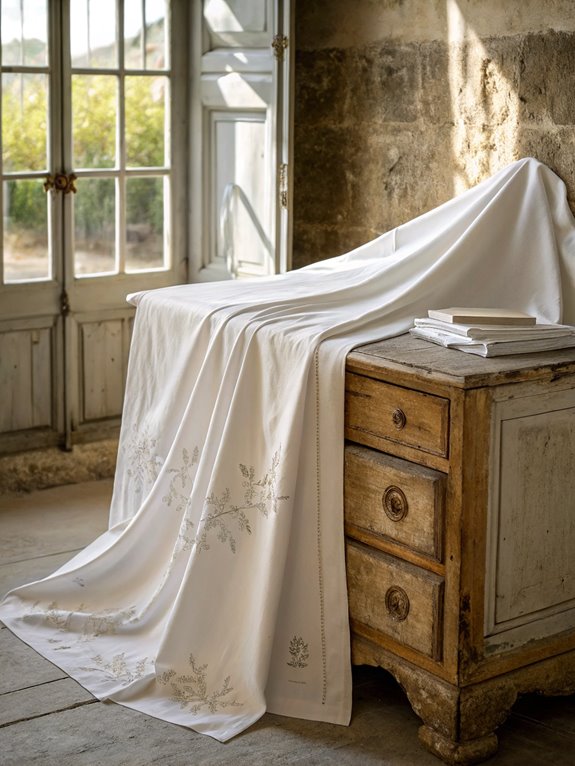
Anyone with valuable furniture or seasonal items knows the importance of protecting them from dust and debris during storage. If you’ve got old bed sheets tucked away, they can serve as perfect dust covers for your cherished belongings. Instead of spending money on expensive storage solutions, your retired linens can step up to do the job beautifully.
Creating dust covers from old sheets is incredibly simple. You can drape full sheets over large furniture pieces like sofas and dining tables, while fitted sheets work wonderfully for smaller items such as end tables and chairs. For oddly shaped items, you might want to cut and hem the sheets to create custom-sized covers that fit just right. Don’t forget to secure them with safety pins or elastic bands to keep everything snug and protected.
The best part about using sheets as dust covers is their breathability. Unlike plastic covers that can trap moisture and potentially damage your items, cotton sheets allow air circulation while still keeping dust at bay. Plus, when they get dirty, you can simply toss them in the washing machine and reuse them again and again.
Beach Blanket
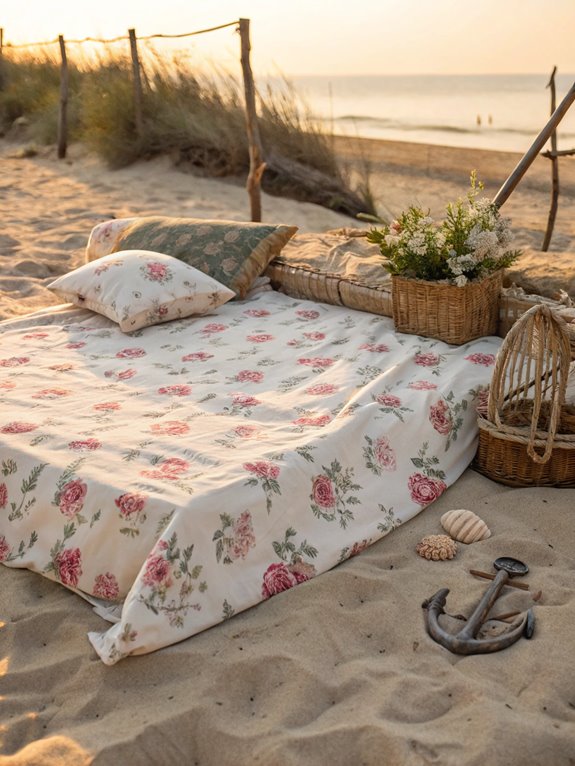
A perfect way to repurpose an old bed sheet is transforming it into a spacious beach blanket. Unlike store-bought beach blankets that can be pricey and often too small, your repurposed sheet provides plenty of room for you and your family to spread out comfortably on the sand.
To create your beach blanket, simply wash and dry your old sheet thoroughly. If you’re feeling crafty, you can add a personal touch by sewing colorful ribbons or trim around the edges. The lightweight cotton material is ideal for beach use – it’s easy to shake off sand and folds up compactly in your beach bag.
One clever trick is to sew small weights into each corner of your sheet-turned-blanket. You can use fishing weights or even large buttons to keep it from blowing away on breezy days. Your DIY beach blanket is also perfect for picnics in the park, outdoor concerts, or stargazing nights. And the best part? If it gets stained or worn out after a summer of fun, you won’t feel guilty about replacing it since you’ve given your old sheet a second life.
Kids’ Fort Building Material
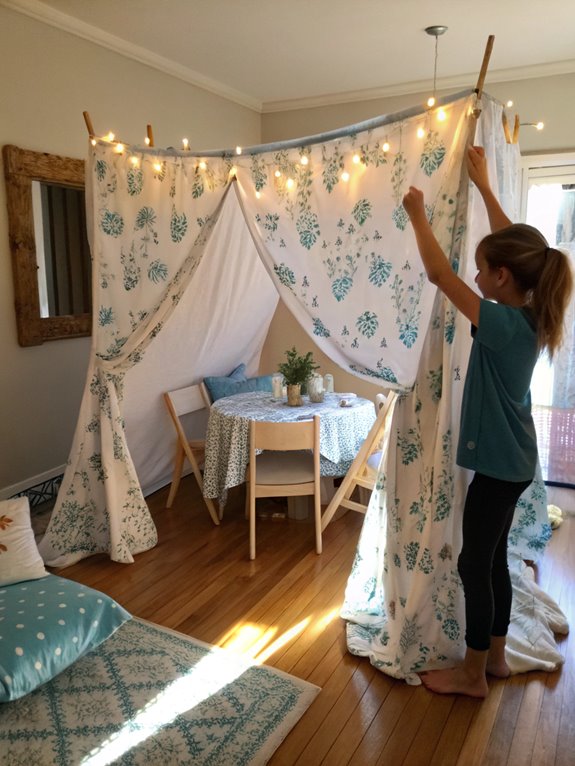
Old bed sheets make ideal materials for children’s fort construction, offering endless possibilities for imaginative play. Their lightweight nature makes them easy for kids to drape over furniture, and their large size provides excellent coverage for creating secret hideouts. You can help your children clip sheets to chairs, sofas, or tables using clothespins or binder clips for secure attachment.
White sheets work particularly well as projection screens for shadow puppet shows, while patterned or colored sheets can transform the fort into themed spaces like castles, spaceships, or jungle hideaways. Your kids can use multiple sheets to create separate rooms or tunnels, making their fort even more exciting. For added stability, try weighing down the corners with books or using safety pins to connect multiple sheets.
Remember to keep a few old sheets specifically designated for fort building – they’re bound to get a bit wrinkled and worn from repeated use. When playtime is over, these sheets fold up neatly for storage until the next adventure calls. It’s a perfect rainy-day activity that encourages creativity and provides hours of entertainment.
Picnic Ground Cover
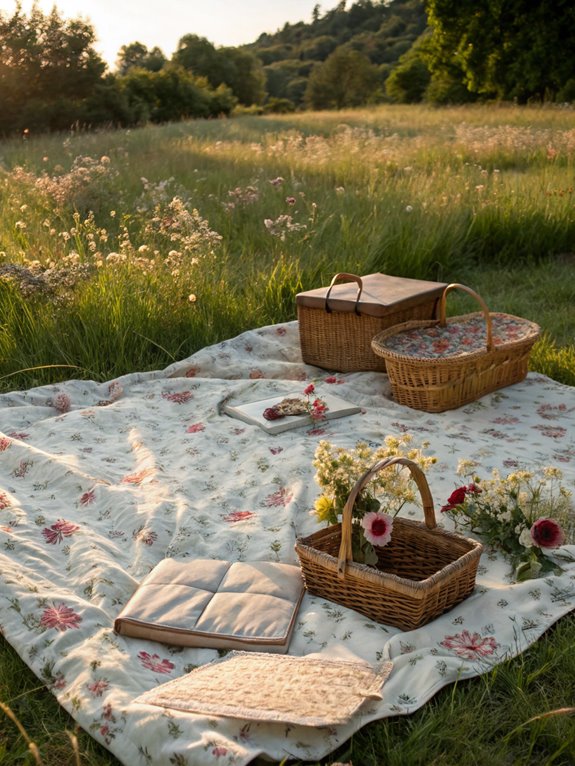
Transform your outdoor dining experience by using repurposed bed sheets as convenient picnic ground covers. Unlike traditional blankets, sheets offer a larger surface area that can accommodate your whole group, and they’re much lighter to carry. You’ll find that old sheets are perfect for protecting you from damp grass and providing a clean space for your outdoor feast.
When choosing a sheet for your picnic, opt for darker colors or patterns that won’t show grass stains as easily. Fitted sheets work especially well because their elastic edges can help anchor your setup on windy days – just tuck a few water bottles or shoes into the corners. If you’re worried about moisture seeping through, you can layer an old shower curtain underneath for extra protection.
After your picnic, simply shake off any crumbs, toss the sheet in the washing machine, and it’ll be ready for your next outdoor adventure. The best part? If your sheet gets damaged or permanently stained during your outing, you won’t feel bad about it since you’ve already gotten plenty of use from it as bedding.
Moving Boxes Padding
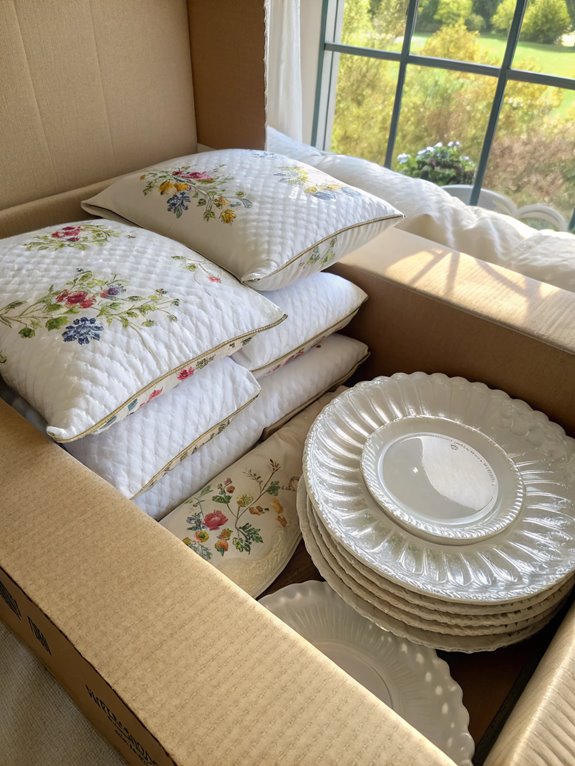
Many delicate items can be safely transported during a move by using old bed sheets as protective padding inside boxes. Instead of spending money on bubble wrap or packing paper, your old sheets can provide excellent cushioning for fragile belongings like dishes, glassware, and decorative items.
To use sheets as padding, simply tear or cut them into different-sized pieces. You can wrap individual items like plates or picture frames, creating a protective barrier against bumps and scratches. Place the larger pieces at the bottom of your boxes for an extra layer of protection, and use smaller strips to fill empty spaces between items.
Don’t forget to use your sheets to separate stacked items too! By layering sheet pieces between dishes or photo frames, you’ll prevent them from scratching each other during transport. You can even ball up sections of the sheets to create custom-sized cushioning that fits perfectly into awkward spaces. As a bonus, you’ll save money on packing materials while giving your old sheets one final purpose before they head to the recycling bin.
Cleaning and Dusting Rags
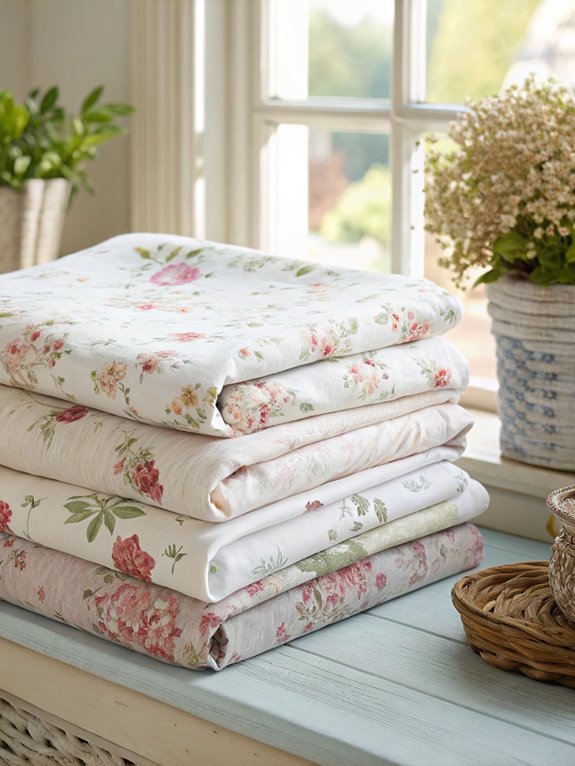
Repurposing your worn bed sheets into cleaning and dusting rags makes practical sense for household maintenance. Instead of tossing out those old sheets, you can cut them into convenient sizes for various cleaning tasks around your home. Cotton sheets are especially effective because they’re absorbent and lint-free, making them perfect for dusting furniture and wiping windows.
To create your cleaning rags, simply use sharp scissors to cut the sheets into manageable squares or rectangles. You might want different sizes – larger pieces for floor cleaning and smaller ones for detailed dusting work. The best part is that these homemade cleaning cloths can be washed and reused multiple times, saving you money on paper towels and disposable wipes.
You’ll find these repurposed rags particularly useful for tough cleaning jobs like washing your car, scrubbing bathroom tiles, or polishing furniture. Keep a stack in your cleaning supplies cabinet, and you’ll always have a fresh rag ready when you need one. Plus, you’ll feel good knowing you’re being environmentally conscious by giving your old sheets a second life as cleaning tools.
Emergency Car Kit Supplies
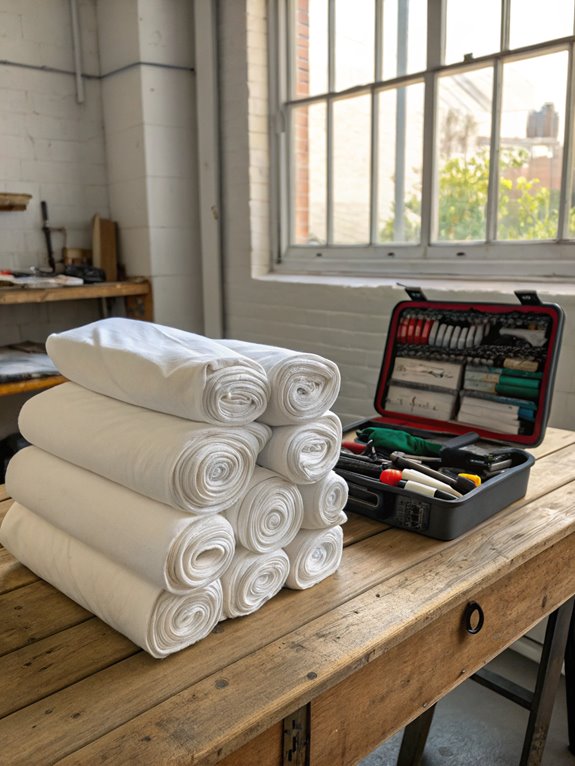
Old bed sheets can serve an important purpose in your vehicle’s emergency kit. When you’re dealing with car troubles on the road, a clean cotton sheet can be incredibly versatile. You can use it as a makeshift ground cover while changing a tire, keeping your clothes clean and protecting your knees from hot asphalt or rough gravel.
Keep a folded sheet in your trunk, and you’ll have an emergency blanket if you’re ever stranded in cold weather. It can also work as a temporary window cover if your car glass breaks, keeping rain and wind out until you can make it to a repair shop. If your car overheats, you can use the sheet as a protective barrier to safely open your radiator cap once the engine cools down.
In case of minor injuries, a clean cotton sheet can be torn into strips for bandages or used as a sling. You can even spread it over your car seats when you need to transport dirty or wet items, protecting your vehicle’s upholstery. Remember to replace your emergency sheet periodically to guarantee it stays clean and ready for use.
Art Smocks
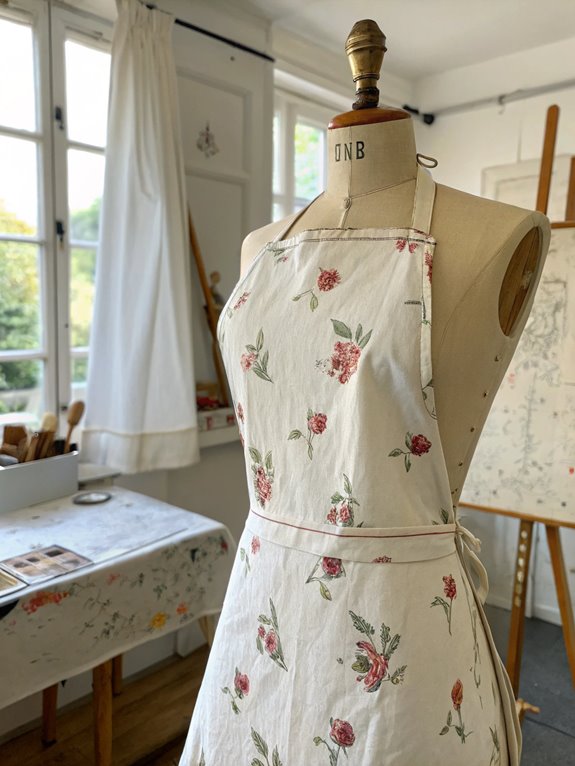
A simple bed sheet can be transformed into a practical art smock, protecting clothes from paint, clay, and other creative materials. Whether you’re crafting with your kids or pursuing your own artistic endeavors, these homemade smocks are both cost-effective and environmentally friendly.
To create your art smock, you’ll need an old sheet, scissors, and some basic sewing supplies. Start by cutting a rectangle that’s wide enough to wrap around your body and long enough to reach from your shoulders to your knees. Cut out a hole for your head and two openings for your arms. You can finish the edges with a simple hem to prevent fraying.
If you’re feeling creative, add some personal touches to your smock. Consider sewing on pockets for brushes and tools, or use fabric paint to decorate it with your name or favorite designs. The durable cotton material of bed sheets makes them perfect for repeated washing, and they’ll soften with each use. Plus, if your smock gets stained beyond repair, you can always make another one from your stack of old sheets.
Fabric Gift Bags
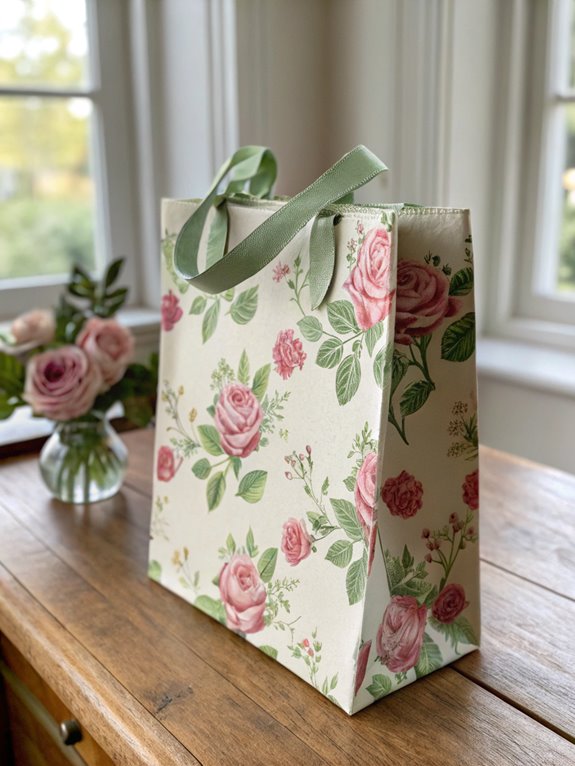
Transform your tired bed sheets into reusable fabric gift bags, offering an eco-friendly alternative to disposable wrapping paper. You’ll save money while helping the environment, and your gifts will stand out with a personal touch that shows you care. Creating these bags is easier than you might think – all you need are some basic sewing skills and a pair of scissors.
Start by cutting your sheet into rectangles of various sizes to accommodate different gifts. Fold each rectangle in half with the right sides facing each other, then sew up the sides, leaving the top open. Turn the bag right-side-out, fold the top edge inward twice to create a clean hem, and stitch it in place. Add ribbon or leftover strips of sheet material to make drawstrings, threading them through the hem you’ve created.
You can jazz up your bags with decorative elements like appliqués cut from contrasting sheet patterns, or add holiday-themed designs using fabric paint. Store your finished bags flat in a drawer, and you’ll always have beautiful, sustainable gift wrap ready to go.
Packing Material
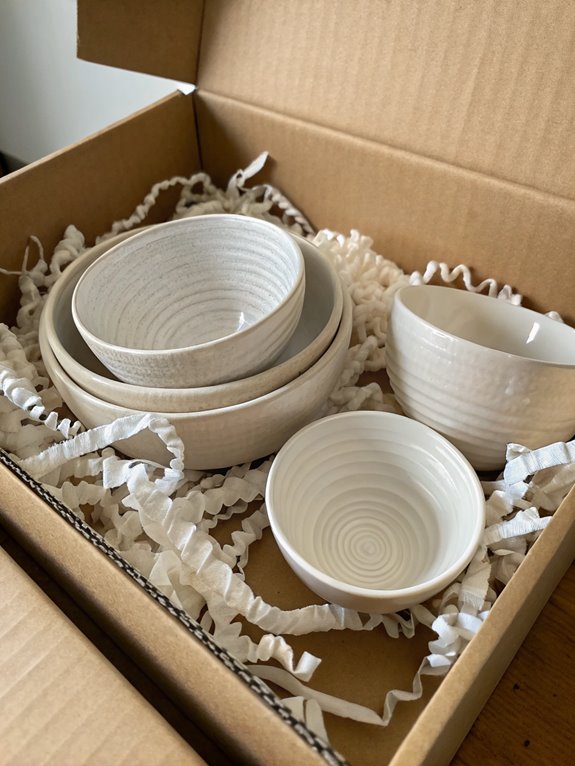
During moves or storage, repurposed bed sheets serve as excellent protective wrapping for furniture, artwork, and delicate items. You’ll find they’re much more eco-friendly than bubble wrap or plastic packaging materials, and they’re already sitting in your linen closet! Just wrap your items securely, and you’ve got instant, cost-free protection.
When you’re packing boxes, cut your old sheets into smaller pieces to cushion fragile items. You can stuff them between plates, glasses, or knickknacks to prevent breakage. They work especially well for oddly shaped items that are hard to wrap with traditional materials. If you’re storing seasonal decorations, wrap each piece in a strip of sheet material to keep them dust-free and protected.
Here’s a clever tip: Use fitted sheets to cover furniture during painting projects or home renovations. The elastic edges help keep them in place better than flat sheets. And don’t forget – if you’re storing items in your attic or basement, sheets can protect your belongings from dust and moisture while allowing them to breathe, unlike plastic covers that can trap dampness.
Compost Bin Liners
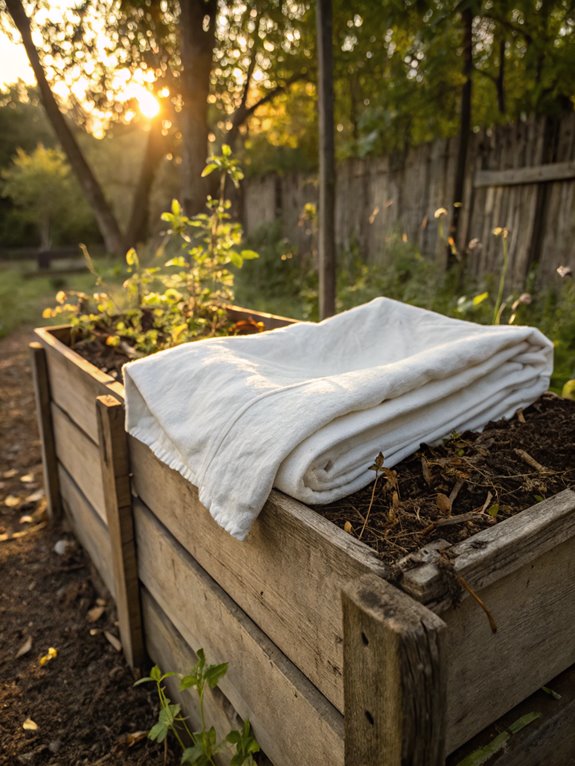
Natural cotton and linen bed sheets make excellent liners for kitchen compost bins, offering an eco-friendly alternative to plastic bags or commercial liners. When you cut your old sheets into manageable squares or rectangles, you’ll have a steady supply of biodegradable liners that won’t harm the environment.
To use your sheet liners, simply place them inside your kitchen compost container, leaving enough fabric hanging over the edges to fold down. As you add fruit peels, vegetable scraps, and other compostable materials, the sheet will collect moisture naturally. When it’s time to empty your bin, you can lift the entire liner with its contents and transfer everything directly to your outdoor compost pile. The best part? The sheet will decompose along with your kitchen scraps!
You’ll want to change your liner every few days to prevent odors and maintain cleanliness. If you’re worried about leaks, you can double-line your bin with two layers of sheet material. This method not only helps reduce waste but also saves you money on store-bought compost liners while giving your old sheets a purposeful second life.
Halloween Ghost Decorations
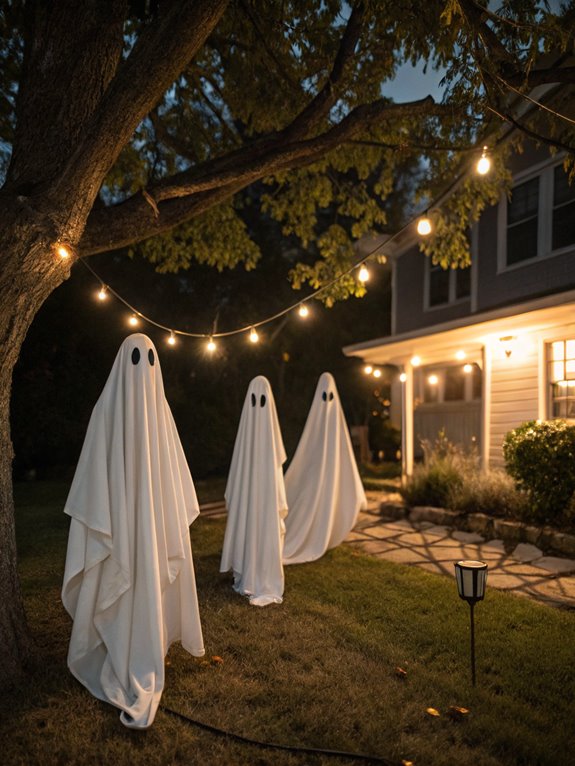
Those old sheets that aren’t suitable for compost can take on a spooky new role as Halloween ghost decorations. With just a few simple steps, you can transform your worn-out white sheets into floating phantoms that will delight trick-or-treaters and party guests alike.
To create your ghost, start by spreading the sheet flat and cutting eye holes – you can make them round, oval, or even angry-looking depending on how scary you want your spirit to be. If you’re feeling creative, add a mouth or other spooky features. Next, find a spot to hang your ghost, like a tree branch or porch ceiling. You’ll need fishing line or clear string to suspend it, creating that eerie floating effect.
For an extra dash of haunting charm, try placing a battery-operated LED light inside your ghost to make it glow at night. You can also use a fan nearby to make your ghost move in the breeze. And don’t forget – the more weathered your sheet is, the more authentic your ghost will look! One sheet can make multiple smaller ghosts, so let your imagination run wild.
Garden Row Markers
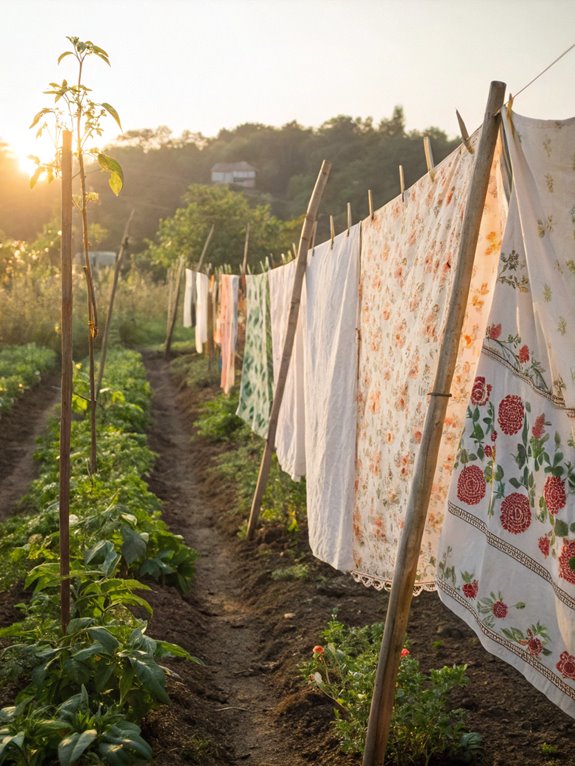
Frugality meets functionality when transforming old bed sheets into durable garden row markers. Your worn-out cotton sheets can find new life in your garden, helping you keep track of what’s growing where. Simply cut the sheets into long strips about 2-3 inches wide, and you’ll have plenty of material to work with.
To create your markers, cut the strips into 12-inch lengths and fold them in half for extra durability. You can write directly on the fabric with a permanent marker, noting the names of your plants, planting dates, and even basic care instructions. The best part? These cloth markers won’t crack or fade like plastic ones often do.
Attach your fabric markers to small wooden stakes using a staple gun, or tie them directly around bamboo poles. You’ll love how they gently flutter in the breeze, adding a touch of whimsy to your garden beds. When they get dirty, just toss them in the washing machine – they’re much more eco-friendly than store-bought plastic markers. Plus, you’ll never mix up your tomatoes with your peppers again!
Quilt Backing Material
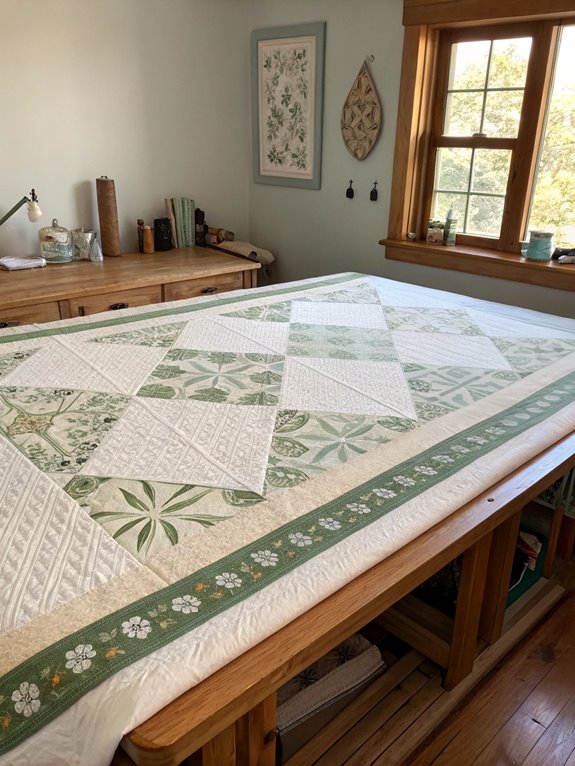
Creating beautiful quilts becomes more affordable when you repurpose old bed sheets as quilt backing material. Your old sheets can provide a perfect foundation for your quilting projects, especially when you take into account that standard quilting fabric can be quite expensive. Cotton sheets work particularly well, as they’re already soft, durable, and pre-shrunk from multiple washes.
Before using your old sheets as backing, make certain they’re free from tears, stains, and worn-out areas. You’ll want to iron them thoroughly to remove any wrinkles, which could cause puckering in your final quilt. If your sheet is patterned, you might want to reflect on how it will complement your quilt top design.
One of the best things about using sheets for backing is that they’re already wide enough to cover most quilt sizes without requiring piecing. This saves you time and eliminates those pesky backing seams that can sometimes show through. Plus, you’re giving new life to something that might otherwise end up in a landfill. Just remember to pre-wash your backing sheet one final time before quilting to make sure it won’t shrink differently from your quilt top.
Frequently Asked Questions
How Many Washes Can Old Bed Sheets Withstand Before Becoming Unsuitable for Repurposing?
The lifespan of bed sheets through washing varies based on fabric quality and care. Generally, good-quality sheets can withstand 200-300 washes while maintaining enough structural integrity for repurposing. That’s about 3-4 years of weekly washing. You’ll know your sheets are reaching their limit when you notice thinning fabric, frayed edges, or small holes – but they’re often still sturdy enough for many creative projects.
Can Bed Sheets With Elastic Corners Still Be Used for These Projects?
While those elastic corners might seem like a frustrating obstacle, they’re actually not a deal-breaker! You can easily snip off the elastic portions and still have plenty of usable fabric for your projects. In fact, some crafters specifically seek out fitted sheets because the elastic corners can be repurposed for hair ties, headbands, or even makeshift rubber bands. Just cut around the corners carefully, and you’ll have two resources in one!
Are Printed Bed Sheets Safe to Use in Garden and Composting Projects?
Most printed bed sheets are safe for garden and composting projects since they’re typically made from cotton or polyester. However, you’ll want to avoid sheets with metallic prints or chemical treatments. Cotton sheets will break down naturally in compost, while polyester won’t decompose but can be used for weed barriers. For extra safety, stick to using plain or naturally-dyed sheets around edible plants.
What’s the Best Way to Sanitize Old Sheets Before Repurposing Them?
Just as a skilled surgeon preps their instruments, your old sheets deserve proper sanitization before their next life. Start by washing them in hot water (at least 140°F) with regular detergent. Add one cup of white vinegar to kill bacteria and remove odors. For extra protection, dry them in direct sunlight, as UV rays naturally disinfect. You can also use color-safe bleach for stubborn stains and deeper cleaning.
Do Thread Count and Fabric Type Matter When Choosing Sheets for Specific Projects?
Thread count and fabric type absolutely matter when choosing materials for different projects. High thread count sheets are perfect for items needing durability, like tote bags or quilts. Cotton sheets work well for most crafts, while silk or satin sheets are better suited for delicate projects like scarves or pillowcases. Lower thread count sheets are ideal for cleaning rags or painting drop cloths since they’re more absorbent.
